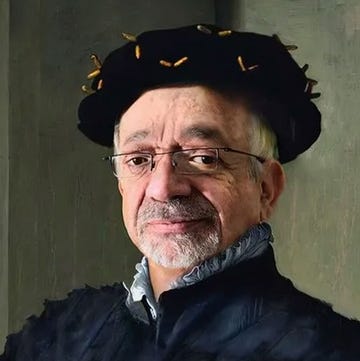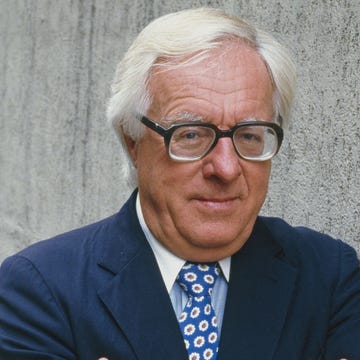I will start by saying that this novel gifted me a newfound fascination with folding towels. You fold an object: You close that object onto itself. The towel is still a towel, but it’s smaller, thicker, layered. You can now see only parts of it, rather than the whole, cohesive picture. You could say that there is an art to towel folding. Or maybe there is a science to it.
That’s a lot of philosophy to assign to a lowly towel, but that’s the type of novel Aja Gabel has written in Lightbreakers: a story that brings the physics of daily life into sharp focus. On one side of the story, you have Maya, the artist; on the other, you have her husband, Noah, a scientist. The novel alternates primarily between their points of view—and later that of Noah’s ex-wife, Eileen, also a scientist. We meet Noah and Maya as they are invited to move to a billionaire’s compound in Marfa, Texas, so that Noah can assist with the Janus Project, a confidential experiment in human consciousness and time travel, involving a machine that allows people to reexperience memories with the knowledge that they have in the present.
This isn’t the type of science fiction that involves space travel, apocalypse, or other futuristic hypotheticals. Although Noah does wonder about—and briefly hope for—the scientific possibility of not only revisiting past events but actually altering them, there is never a plan to go back in time and alter the grand course of history. Instead, Gabel deals in what propels the minutiae of our lives as they already exist in the present: the science of our individuality and our memories, the fiction of grief as a single emotion with a concrete beginning and end. Here, memory is both science and fiction; we remember events that actually happened, but we only remember them through our own specific filters. The book begins and ends with the same scene, Maya and Noah’s first date, but in the beginning it’s portrayed as a conversation about art from Maya’s perspective, and in the end it’s a conversation about science from Noah’s. Is one depiction more accurate than the other? Does the “actual” objective truth matter more than each person’s own subjective truth? In Noah’s scientific view of the world, “a statement [is] not true until proven true through math; reality was suspicious until it had a corresponding equation.” In Maya’s artistic philosophy, however, answers “came through penumbra, outlining the part of the gesture that wasn’t quite visible.”
Much of the novel feels like a conversation, sometimes a battle, between art and science, subjective and objective. Gabel uses one piece of art in particular, a fictional photograph titled Weight, to demonstrate the subjectivity that memory shares with art. In the piece, a woman stands on the edge of a building, a cluster of balloons just beyond her reach. The “dynamic sadness” that both Maya and Noah initially see in the image—an interpretation that bonded them when they first met—later morphs into “relief” for Maya when she flees Marfa for Tokyo. “The subject, Yuko, was about to relieve herself of gravity…of the weight of the past, its re-creations and reflections.” Maya’s ex, another artist with a much more successful career than hers, sees the photograph as “bright and hopeful.” Eileen, Noah’s ex-wife, “wondered what it said about you, which you noticed first, the happiness or the sadness, the possibility or the inevitability. She’d seen the exuberance first, the joy.” The factual information in the photograph is only half the truth; the other half is the personal truth the viewer brings with them, usually influenced by whatever the person happens to be experiencing in their life at the time. Ironically, the photograph, a work of art, serves a very scientific function as a litmus test for what each character is feeling in the moment.
The machine used in the Janus Project, conversely, approaches memory from a scientific standpoint. The machine almost creates a living photograph: a memory you can not only document but actually step inside and inhabit. And this is where my towel-folding philosophy comes back into play; Gabel uses the term “fold” to describe the process of entering this machine and sending your consciousness back in time to a specific memory. There doesn’t seem to be any room for subjectivity, because you are reliving the memory exactly as it happened the first time. Noah is an obvious choice of subject for this experiment—to the reader, at least, if not to himself—because he is still mourning the death of his toddler from his previous marriage. He can’t wait to relive memories of his daughter. The experiment is complicated, however, when he invites Eileen to see it for herself, knowing that she won’t be able to resist the pull of her own lingering grief. Although they relive the same exact memory at the same exact time, their experiences of the memory are warped by their differing manifestations of grief.
“Grief didn’t work the way people thought it did,” Gabel writes. “Noah found that you didn’t move through grief linearly, going through whatever stages therapists told you about, and you didn’t come to this point where you accepted it and your new life could begin.” Grief, Gabel suggests, is a kind of time machine. You were one person before the grief happened; the grief tosses you around, spits you out, and folds time into this weird mess of past, present, and future happening all at once. Just as the towel is still a towel after you fold it, you’re still you while the grief is happening, but you’re a different version of yourself. No matter how hard you try to look to the future, you’re constantly whipped back into the past.
I won’t give away the book’s ending. I will just say that, predictably, the billionaire got a lot of things wrong in his myopic quest to throw money at the rules of physics while putting human lives at stake, and his fate is well deserved, even if it feels almost too good to be true. At the end of the story, Maya, Noah, and Eileen have each reached a point of closure in their own personal searches. They have brought the past to the surface and folded it into the present. I’m not sure there’s ever a complete, satisfying closure for all types of grief, but I think there is a point of deeper understanding. You fold until you can’t anymore. You start to loosen your grip. Eventually, with some unexpected relief, you unfold.•
Jackie DesForges is a writer and artist in Los Angeles. Her work has appeared in the New York Times, Off Assignment, the Coachella Review, Air/Light, and more.













